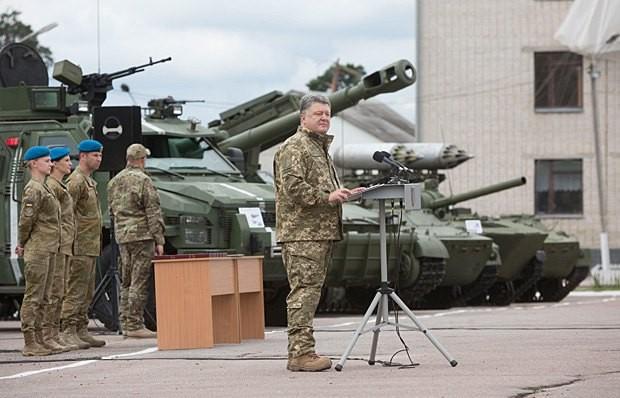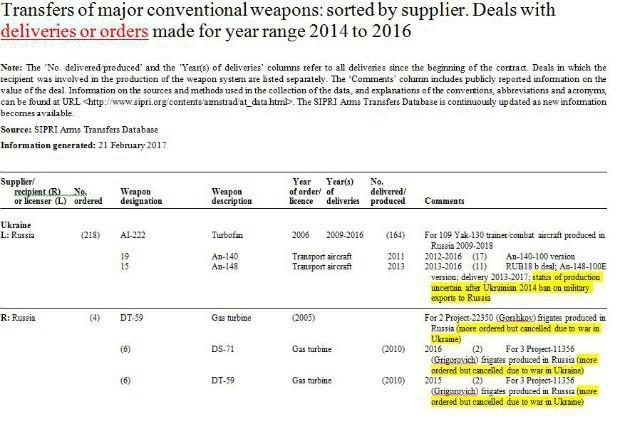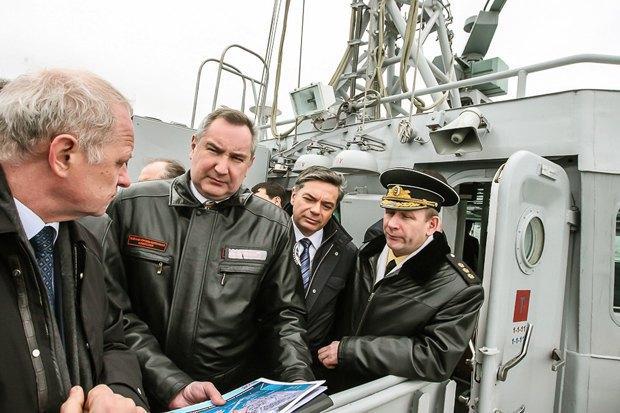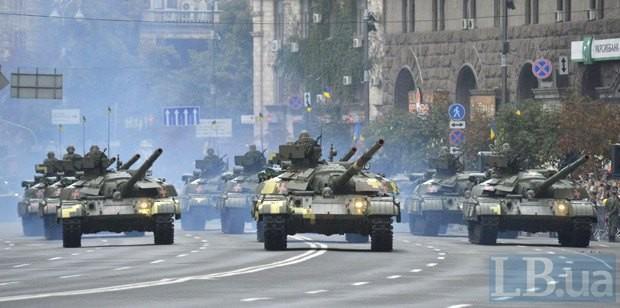The Stockholm International Peace Research Institute (SIPRI) on 19 February published a report on arms transfers on the global market puting Ukraine among the world's top-10.
Misinformation campaigns defaming Ukrainian arms pursue specific goals. First, they are used to show European partners that "while Europe subjects Russian companies to sanctions, Ukraine continues to sell its output to the Russian Federation". Second, to show Ukrainians that their "state, instead of sending arms to the front line, sells it to the aggressor state". Third, to undermine Ukraine's position on the international arms market because, as the SIPRI report, among all, shows, Ukraine is clearly putting up competition to Russia here. Fourth, this way the Russian authorities are trying to cover up their crimes in Donbas.
The Stockholm International Peace Research Institute (SIPRI) on 19 February published a report on arms transfers on the global market. Its rating puts Ukraine among the world's top-10 largest suppliers of military-purpose goods.
Instead, the institute's findings on Ukrainian arms exports were used for a smear campaign against Ukraine.
Myths about Ukrainian exports to Russia
Some Ukrainian media have started juggling data contained in the SIPRI report to say, look, Ukraine's largest arms makers continue to sell their output to Russia which, according to the reports, the second biggest importer of Ukrainian military products.
Indeed, the exporters rating clearly shows that the share of Ukrainian arms on the Russian market is around 17 per cent and thus the Russian Federation takes the honorary second seat among customers for Ukrainian arms.
Or that is how certain media interpreted the report. What did the SIPRI say in fact?
The SIPRI's data covers not the last year but a five-year period (from 2012 to 2016). Indeed, Ukraine supplied military-purpose goods to Russian concerns but this was back in Viktor Yanukovych's times. For example, on 7 May 2012, Ukrainian state-owned enterprises were surprisingly included in the modernization plan of the Russian defence industry. The Kremlin had no doubts back then that it would soon gulp down the Ukrainian state to restore the old empire together with its system of military cooperation.
However in 2014, after the Kremlin's aggression against Ukraine and after Ukrainian President Petro Poroshenko signed decree No 691 "On measures to advance state military and technical policy", Ukrainian state-owned companies stopped supplying military-purpose and dual-purpose goods to Russia.
To see that exports to Russia stopped, it is enough to look at the data of the State Export Control Service which the SIPRI receives each year.

In particular, the report for 2015, unlike in the previous years, does not contain any information about Ukrainian arms supplies to the Russian Federation. At the same time, Ukrainian-made military-purpose goods were in greater demand in other regions of the world.
It is obvious that in the past two years, Ukraine (the information contained in the SIPRI report) could diversify arms supplies, having left the Russian market.
In 2016, the state-owned enterprise Ukroboronprom managed to sign 25 per cent more export contracts than in 2015. "Over the past year, we have exported equipment worth 750m dollars, which is 25 per cent more than a year earlier," the company's deputy director, Denys Hurak, said.
Despite the rather positive performance of the domestic defence industry, Ukrainian media continue to speculate on the issue of Ukrainian arms supplies to Russia. So let's see what it is all about.
Treason reversed
If you open a small table listing arms exporting countries on the SIPRI website, you will find information on the cost of signed procurement contracts and items of expenditures.
In particular, certain journalists noticed that in 2016, Russia imported 169m dollars worth of military products and got indignant pointing fingers at those who sold goods illegally: the Zaporizhzhya aircraft engine plant Motor-Sich and the state-owned enterprise Antonov incorporated into the Ukroboronprom concern.
So journalists saw the table and spread the rumours of treason but failed to work out what the SIPRI figures mean.
For example, about the supply of 164 turbojet bypass engines AI-222-25 by Motor Sich to Russia, which can be used in Russian combat trainers Yak-130.
Anatoliy Malysh, director for public relations at Motor Sich, said: "Motor Sich works to the extent permitted under applicable law and has not been engaged in military and technical cooperation with Russia since the moment the authorities took an official decision to ban cooperation. The company stopped supplying AI-222 engines for Yak-130 combat trainers to Russia back in June 2014. We did not supply AI-222 to Russia either in 2015, or 2016, or 2017."
Allegations were also levelled against the state-owned Antonov that it allegedly continues to supply An-140 transport aircraft to Russia.
Those who made the allegations forgot that on 11 February 2013, in Yanukovych's times, the Kyiv-based concern and Samara-based Aviakor signed an agreement under which Russia bought from Ukraine the intellectual property right to military-transport models of the Ukrainian aircraft An-140T, An-140S and passenger An-140-100 manufactured for the needs of the Russian Defence Ministry.
Indeed, in May 2016, the Samara-based plant handed an An-140 aircraft over to the Russian Defence Ministry. "Samara-made An-140 aircraft have for several years now been used by Russian military agencies. An-140 was also mentioned at a meeting on the development of aircraft construction, which was chaired by the Russian president on 12 May, as one of four possible options of a regional aircraft. In fact, An-140 is the only option out of those on display which has been manufactured in Russia, here at Aviakor, for more than one year," the plant's director-general, Aleksey Gusev, said.
Namely this aircraft was included in the SIPRI register. But why did this happen? The reason is that Russians bought the intellectual property right but not the licence because Ukraine refused to do this. In other words, they can manufacture any of the three mentioned An models but they cannot modernize them, change the list of spare parts, sell aircraft on the foreign market and so on. This would require a manufacturing licence.
Thus, the Samara plant manufactured a Ukrainian AN plane assembled in Russia. Even the Russians confirm that the state-owned Antonov enterprise does not supply its products to Russia. "In mid-2015, the Samara-based Aviakor plant suspended the assembly of An-140 because 34 supplier plants located in Ukraine stopped sending in the parts. We will not be able to replace them with Russian-made parts any time soon because the main design bureau is in Ukraine (state-owned Antonov). The remaining aircraft were assembled out of spares available at the plant," Russian Industry and Trade Minister Denis Manturov said.
Indeed, in May 2013, right after it bought the intellectual property right from Antonov, the Russian aviation plant signed a new contract to manufacture and supply three An-140-100 aircraft. However aircraft assembly stopped in 2015. And the aircraft manufactured in May 2016 was the last An which Aviakor managed to put together because none of Ukrainian companies would supply it with parts after 2014.
At the same time, the state-owned concern Ukroboronprom said that the SIPRI published inaccurate data which was later used for manipulations. The concern's representatives presented a screengrab of the query on the SIPRI official website concerning the deals on supply and order of arms between Ukraine and Russia, which confirms that Ukrainian Antonov did not sell products to Russia.
SIPRI is also wrong
This is not the first case when the SIPRI publishes unverified reports on the export of Ukrainian arms.
For example, a similar scandal broke out in 2015 over the sale of the Ukrainian transport ship Georgiy Agafonov, which is now sailing high seas under the Russian flag, was renamed Kazan-60 and is taking part in the Syrian conflict.
At the time, without checking out the situation, Ukrainian journalists accused the country's authorities of "trading with the occupier". It was said that the Ukrainian Danube Shipping Company sold the vessel through a so-called Mongolian shell company after which it was immediately bought by the Russian Defence Ministry in the interests of the Russian Navy.
In fact, it was not a Mongolian company but the port of registration: landlocked Mongolia offers rather beneficial financial terms for "maintaining" hundreds of vessels. Indeed, in late 2014, the Ukrainian Danube Shipping Company sold the bulk carrier to the Turkish company 2E DENIZCILIK SAN. VE TIC.A.S. Soon the vessel was towed away to Turkey to be scrapped but the Turks sold it to Russians.
But let's get back to the Stockholm institute and its report.
Indeed, the SIPRI published factual information on 169m-dollar contracts between Ukraine and Russia, which were allegedly signed in 2016. Hardly did anyone pay attention to the note in small font in the explanation to these contracts: it said that supplies were stopped back in 2014. But in most cases the deadline for arms supplies was clearly indicated as 2016.

It turns out that figures for the past year include the remaining cost of procurement contracts suspended in 2014 which were not implemented.
The SIPRI methodology allows for changes to arms flows to be tracked and their geographical distribution to be determined. But overall this system by and large differs from official statistics.
What's the big idea?
So the SIPRI was not accurate. And someone decided to use some Ukrainian media to fuel up tension in the country with the help of this information.
The main customer for such attacks is the Kremlin which uses stooges among certain Ukrainian media which sold their independence to propaganda departments of the Russian special services or fugitive officials of the Yanukovych era (the former being the same as the latter).
Clearly, the misinformation campaign that was launched pursues specific goals.
First, it is used to show European partners that "while Europe subjects Russian companies to sanctions, Ukraine continues to sell its output to the Russian Federation".
Second, to show Ukrainians that their "state, instead of sending arms to the front line, sells it to the aggressor state".
Third, to undermine Ukraine's position on the international arms market because the SIPRI report makes it clear that Ukraine is putting up competition to Russia here.
Fourth, the Russian leadership, which organized yet another information attack against Ukraine, is thus trying to cover not only its failures on the global market but also its crimes in Donbas.
Apart from global arms transfers, the SIPRI report talks about illegal transfers of Russian arms to Donbas militants. It says that the Russian Federation supplied the terrorists with tanks, surface-to-air missiles and anti-tank systems.
It would not be inappropriate to recall the Russian Buk anti-aircraft system which was brought by Russian servicemen from Russia to the territory controlled by pro-Russian militants and later used to shoot down the Malaysia Airlines Flight 17 aircraft.
What is interesting is that information attacks against Ukraine concerning arms are happening amid US Senators' regular calls on the White House to give Ukraine lethal weapons to resist the aggressor.
"What [the Russians] continue to do in eastern Ukraine, in Donetsk, gives no indication they're backing off," US Senator Dick Durbin of the Democratic Party said. "We have to give to Ukraine the tools and weapons they need to protect their own people."
Russian audience for information attacks
Apart from turning the international attention from the obvious and indisputable evidence of Russian crimes in Donbas, the Kremlin also "cares" about the Russian audience.
After massively spreading false stories through some Ukrainian media, Russia officials started to say on state-owned TV and in various news outlets about "lying" Ukrainian journalists who published wrong information about procurement deals. Because the Russian audience has to be confidence that the idea of import replacement invented by Russian Deputy Prime Minister Dmitriy Rogozin is working and therefore Russia no longer needs to Ukrainian imports.

In fact, Russia's import replacement policy is a total failure, which is a separate issue for discussion. Back in 2015 Rogozin said at a maritime board meeting in St Petersburg: "Billions were spent on the development of local parts for shipbuilding. The money is gone without any result," Fontanka said. According to experts, the same is true to all sectors of the Russian defence industry.
And in the meantime jet fighters exported to India are collecting dust in hangars because new engines reassembled in Russia would not start. Russian tanks get stuck during a parade, the launch of 26 Soviet-time Kalibr cruise missiles in unknown direction, or the deployment to Tartus and return of the smoke-belching Kuznetsov, a stupid parody of the aircraft carrier, could only make the whole world laugh.
This may be the reason why Dmitriy Rogozin has been asking Antonov engineers to move to Russia while promising them manna. The price of Russian promises can be perfectly seen in Donbas and Crimea. Therefore let us hope that the plans of Rogozin and those Ukrainian media who serve the aggressor country will not come true.

